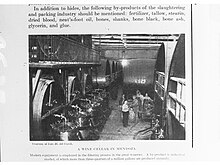Mendoza wine

History

The region of
Climate and geography

Located in the far western expanse of Argentina, the
The soil of the Mendoza wine region is primarily
Wine producing areas
As of 2008, the Mendoza region contained more than 356,000 acres (144,000 hectares) of planted vineyards-producing nearly two-thirds of the entire Argentine wine production.
Argentina's most highly rated Malbec wines originate from Mendoza's high altitude wine regions of Lujan de Cuyo and the Uco Valley. These Districts are located in the foothills of the Andes mountains between 2,800 and 5,000 feet (850 and 1,520 m) elevation.[7][8][9][10]
The subject of elevation is of much interest to the wine world because with increased altitude, the intensity of the sunlight increases. The role of this increased light intensity is currently being investigated by Bodega Catena Zapata's research and development department headed up by Laura Catena, Alejandro Vigil and Fernando Buscema.[11]
Grape varieties
The pink-skinned varieties of Cereza and Criolla Grande have historically formed the backbone of the Mendoza wine industry and today still account for around a quarter of all vineyard plantings. Used primarily for inexpensive
See also
- Bodega Catena Zapata
- Dominio del Plata Winery
- Lagarde (winery)
- Edmund James Palmer Norton
- Trapiche (winery)
References
- ^ ISBN 0-19-860990-6
- ^ ISBN 978-3-8331-4611-4
- ^ J. Jimena "Sipping and celebrating in Mendoza" Globe and Mail, Jan 17th 2004
- ^ a b c d e La vid y el vino en América del Sur: el desplazamiento de los polos vitivinícolas (siglos XVI al XX)
- ^ "Mendoza Travel Guide for Wine Lovers". www.winetourism.com. Retrieved 2022-07-27.
- ^ V. Lombardi (author) International Sommelier Guild; December 2002 Archived 2011-07-13 at the Wayback Machine
- ISBN 978-0-8118-7330-7.
- ISBN 978-987-20926-3-4.
- ^ WINE TOURS: Argentina - Mendoza Archived 2011-01-12 at the Wayback Machine, "Fly Fishing Patagonia"
- ^ Wine Tip: Malbec Madness, "Wine Spectator", April 12, 2010
- ^ Visiting Mendoza, Argentina, Wineanork"
External links
- Argentina's Mendoza wine route: top 10 guide - published by The Guardian, April 2015
